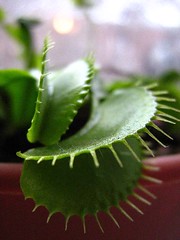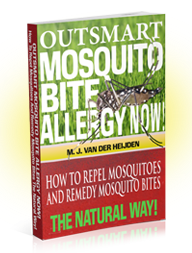Growing Venus Flytraps
Arguably the most famous among the carnivorous plants, a [pullquote]Venus Flytrap continues to capture interest from gardeners and plant enthusiasts because of its ability to trap and feed on insects.[/pullquote] Its trapping mechanisms were selected by evolution to allow them to survive despite harsh environments.
Its biological name is Dionaea Muscipula and it is native to the East Coast of the United States. They commonly thrive on subtropical wetlands although different varieties grow in different parts of the world as well.

Virgil the Venus Flytrap—sophistikittenlin (Flickr.com)
Generally, these plants are small with the maximum size of the stem of about 3-7cm. Its common preys are arachnids and different kinds of insects. Their trapping mechanism is triggered by the hairs found on the inner surface of the plant’s leaves.
The amazing part about this mechanism is that the trap closes only when there is contact in various hairs within 20 seconds. This redundant triggering safeguards the plant from wasting energy on objects that do not have nutritional value.
These specialized plants attract insects with its color and the sweet nectar that it secretes. Unlucky preys that fall into this trap are digested within 4-10 days. The more the prey struggles, the tighter the trap gets.
Once the digestion is done, the trap opens leaving the hard exoskeleton of the insect it fed on. These remaining parts are either dropped to the ground or blown away. Unlike most plants that get nutrition from the sun, Venus Flytraps get all the nutrition they need from insects. They feed on about one to two flies or insects a week.
Many people are now growing these flytraps both for amusement and for scientific purposes. They are commonly cultivated although they are known to be difficult to grow. Successful propagation requires recreating the plant’s natural habitat.
There are a couple of pointers to keep in mind for the successful propagation of these plants. For one, it is never good to feed the plant with human food or meat. Putting these plants in the right area is also very important. If grown at home, it is best to put them in a sunny area since they need at least six hours of exposure to the sun each day.
In terms of soil, these plants require those with acidic PH. They also need to be re-potted at least once in two years. Tap or bottled water are not recommended sine its chemicals build up to the soil and eventually kill the plant. They grow best with rain water instead.
Venus Flytraps are fascinating but growing them is not easy. It will help to follow the simple tips mentioned earlier to succeed in this venture.
Filed under: Mosquito Eating Plant
Like this post? Subscribe to my RSS feed and get loads more!




Leave a Reply
You must be logged in to post a comment.